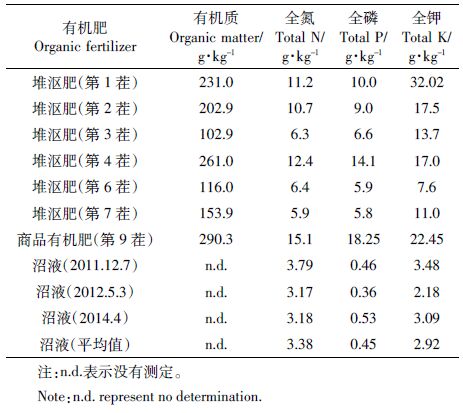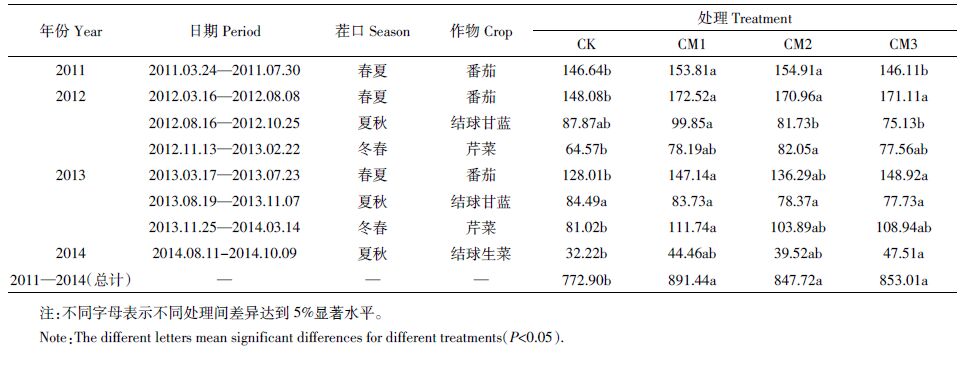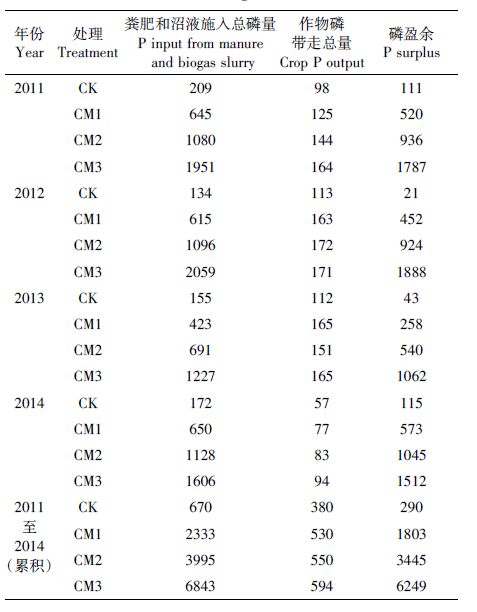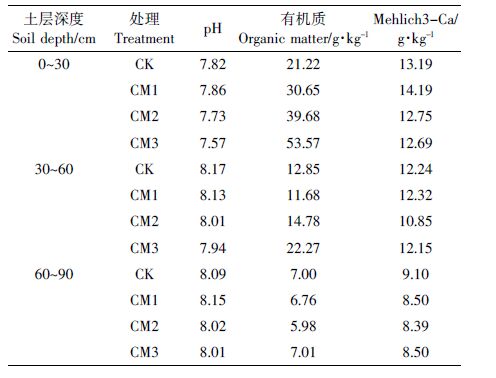文章信息
- 王敏锋, 严正娟, 陈硕, 高杰云, 李吉进, 许俊香, 陈清
- WANG Min-feng, YAN Zheng-juan, CHEN Shuo, GAO Jie-yun, LI Ji-jin, XU Jun-xiang, CHEN Qing
- 施用粪肥和沼液对设施菜田土壤磷素累积与迁移的影响
- Effects of manure and biogas slurry applications on phosphorus accumulation and mobility in organic vegetable soil under greenhouse
- 农业环境科学学报, 2016, 35(7): 1351-1359
- Journal of Agro-Environment Science, 2016, 35(7): 1351-1359
- http://dx.doi.org/10.11654/jaes.2016.07.018
文章历史
- 收稿日期: 2016-03-22
2. 北京市农林科学院植物营养与资源研究所, 北京 100097
2. Institute of Plant Nutrition and Resources, Beijing Academy of Agricultural and Forestry Sciences, Beijing 100097, China
有机蔬菜设施园区普遍施用粪肥和沼液来提供养分,粪肥中较低N/P 比例与蔬菜对较高N/P 比例需求不匹配,必然导致磷素过量投入问题[1-4]。研究表明, 设施蔬菜生产中,磷素的当季利用率不足10%,由于磷素扩散速率较慢,大量磷素在菜田土壤中累积[5]。
很多人认为磷素在土壤中易被吸附和固定,不易发生移动损失[6],但是由于投入土壤中的粪肥和沼液中包含较多水溶态以及有机态和胶体态磷,这些形态的磷素在土壤中易发生移动[7-9],在设施菜田大量而频繁灌溉的条件下,磷素淋失的风险更大。 Sharpley 等[10]研究表明,施用有机肥能够明显提高磷素在土壤中的迁移性、增加磷素的淋溶强度。 Heckrath 等[11]提出土壤磷素淋溶的Olsen-P“突变点”为60 mg·kg-1。严正娟[12]汇总分析我国不同区域菜田土壤磷素淋溶的土壤Olsen-P“突变点”在50~ 80mg·kg-1 之间。Leinweber 等[13]研究表明,土壤磷饱和度(DPS)与土壤渗漏水中磷浓度呈显著相关关系,它是判断土壤磷素流失潜力的重要指标。欧洲一些国家把DPS 值的25%作为判定土壤磷流失潜能的临界值[14],而薛巧云[15]对我国北方和西北地区75个石灰性土壤进行研究发现,我国石灰性土壤DPS 临界值为28.1%。当土壤中磷素的累积量达到并超过临界值时,其淋失风险急剧增加,进而污染水体。
针对当前有机蔬菜设施栽培条件下,盲目施用粪肥和沼液可能导致的磷素累积和迁移等问题,本文基于北京市延庆县长期定位试验,研究了基施不同量的牛粪和鸡粪的混合堆沤肥,再追施相同数量沼液情况下,设施菜田作物的产量效应、土壤各形态磷素累积及其潜在的环境风险,旨在为有机蔬菜设施栽培体系中有机肥的合理施用上限、降低土壤磷素累积、减少环境风险提供理论参考。
1 材料与方法 1.1 试验地点及供试土壤试验设在北京市延庆县康庄镇小丰营村现代设施农业示范基地。地处北京西北部的延怀盆地东部(115°54'E、40°24'N),位于延庆县西南部,海拔高度500m 左右,属温带与中温带、半干旱与半湿润带的过渡连带气候区,冬冷夏凉,年平均气温8 益,年平均降雨量443.2 mm,无霜期150~170 d。
试验在土壤肥力均匀、质地为轻壤的有机蔬菜种植温室进行,该温室前茬作物为青椒。供试土壤为潮褐土,试验前为多年有机蔬菜大棚菜地,土壤肥力较高,0~20 cm土层土壤基本理化性状见表 1。

|
试验于2011 年3 月至2014 年10 月进行,共种植10 茬蔬菜。选取番茄、结球甘蓝、芹菜、结球生菜作为供试作物。具体种植情况见表 2。
试验依据粪肥的施用量设置4 个水平,分别在每茬种植前施用。第1~8 茬,供试粪肥为鸡粪、牛粪以及土壤为原料自制的堆沤肥,4 个施用水平分别是0、52.5、105、210 t·hm-2(按干重计算);第9~10 茬,供试肥料改为商品有机肥,并且调整了施用量,分别为0、30、60、90 t·hm-2(按干重计算),分别以CK、CM1、 Cm2、CM3 表示。粪肥全部作为底肥一次性施入,然后翻耕,深度为10~15 cm,其中番茄、结球甘蓝和结球生菜生育期按相应处理施用底肥,而在芹菜生育期(第5、8茬)则没有进行粪肥施用处理。试验设置3 次重复,随机区组排列。
小区面积为25.2 m2,包括3 个畦,每畦面积8.4 m2(1.4 m×6 m)。蔬菜轮作过程中,各处理小区位置保持不变。
试验中通过滴灌追肥方式对各处理施用相同量的沼液或清水。番茄生育期内滴灌稀释施用沼液量为525m3·hm-2;结球甘蓝和结球生菜生育期内滴灌稀释施用沼液量为260 m3·hm-2;芹菜生育期内不追施沼液。堆沤肥和灌溉用的稀释沼液养分含量见表 3。病虫害防治和日常管理按照园区标准化操作规程进行,定植当天滴灌清水。

|
在每个小区的中间畦进行产量测定。番茄多次采收,详细记录各次采摘果实的鲜重,最后将产量累加, 将小区产量换算为每公顷产量。结球甘蓝和结球生菜收获时,记录整个小区的产量,换算为每公顷产量。芹菜收获时,代表性划定1 m2采集样品,称重计产,换算为小区产量,最后将小区产量换算为每公顷产量。
番茄果实:盛果期在每小区取10~15 个成熟待收获的番茄果实样品,切碎混匀,分取200 g烘干,测定果实含水量,烘干样品粉碎后待测。番茄茎叶:拉秧后,每小区取5 株有代表性番茄植株茎叶,称鲜重,切碎混匀,分取200 g烘干,测定茎叶含水量,烘干样品粉碎后待测。结球甘蓝、芹菜和结球生菜:每小区在植株成熟时取5 株有代表性植株,切碎混匀,分取200 g 烘干,测定含水量,烘干样品粉碎后待测。
植株全磷含量采用H2SO4-H2O2 消煮-钒钼黄比色法测定。试验中作物磷养分带走量由下列公式计算而得:
 (1)
(1)  (2)
(2)  (3)
(3) 2014 年10 月在作物收获前采用1 m长的直径2 cm 土钻采集土壤样品,每个小区分为0~30、30~60、 60~90 cm 3 层取样,取样位置为中间小区的两植株中间,每个小区按“S”形各取4 钻,然后分层混为一个土样,分装在袋子中,放入冰盒中带回实验室。将土样风干过2 mm 筛,分别测定土壤Olsen-P、CaCl2-P、 Mehlich3-P、土壤磷饱和度(DPS)、全磷、有机磷、pH、 有机质。
常规项目测定均采用常规农化分析法[16]。项目测定如下:
Olsen-P 用0.5 mol·L-1 NaHCO3(pH=8.5)溶液提取(水土比20:1)后采用钼锑抗比色法测定[17];CaCl2- P用0.01 mol·L-1 CaCl2 溶液(水土比5:1)浸提后钼锑抗比色法测定[18-19];Mehlich3 浸提液提取的土壤溶液(水土比10:1)用ICP 测定P(M3-P)、Ca(M3-Ca)和Mg(M3-Mg)含量[20-22];全磷采用H2SO4-HClO4 消煮- 钼锑抗比色法测定;有机磷测定采用灼烧法;水提取土壤溶液(水土比为5:1)pH 用酸度计测定;有机碳采用重铬酸钾氧化法[23]测定。
土壤DPS 的计算公式为:
 (4)
(4) 公式(4)参见薛巧云[15]对我国北方和西北地区75 个石灰性土壤研究的结果,M3-P、M3-Ca 和M3-Mg 分别为用M3 浸提液提取、ICP 测定的土壤P、Ca 和Mg 含量(mmol·kg-1)。
1.4.3 土壤磷素盈余的计算方法土壤磷素表观盈余的计算:
 (5)
(5) 粪肥和沼液投入的养分按粪肥和沼液用量以及粪肥和沼液养分含量计算,作物养分带走量见公式(1)(2)(3);由于第2 茬和第9 茬遭受虫灾,没有测定产量及养分含量,其对应处理的磷素带走量按第1、 3、6 茬计算得到的番茄磷素带走量的平均值进行估算,第10 茬结球生菜的磷素带走量用其产量乘以相应的系数(生菜为0.31 kg P·1000 kg-1 蔬菜[12]);第5 茬和第8 茬未施粪肥和沼液,第10 茬施用的商品有机肥的磷素含量按第9 茬测定的商品有机肥进行计算;沼液中磷素含量在第1、4、6、7、10 茬没有分析结果,按在第2、3、9 茬分析结果的平均值估算。
1.5 统计分析数据统计采用Microsoft Excel 2010 软件,采用IBM SPSS Statistics 21 中ANOVA 程序对数据进行单因素方差分析,5%显著水平。
2 结果与分析 2.1 蔬菜产量和土壤磷素盈余 2.1.1 作物产量与单施沼液处理相比,施用粪肥增加了作物产量,但是随粪肥施用量的增加,产量并没有持续增加, 甚至在一些茬口出现减产情况(表 4)。由此可以看出,粪肥的施用量并非越多越好,过量的粪肥施用,可能加剧了土壤中养分的不平衡,进而引起作物的减产,同时也会造成农田环境污染。

|
施用不同数量粪肥对设施菜田土壤年均磷素盈余量如表 5所示。不同处理条件下,土壤磷素每年均有不同程度的盈余,表现为粪肥用量越多,土壤磷素盈余越多。2011—2014 年磷素累积盈余量在基施不同用量粪肥(CM1:30 t·hm-2;CM1:60 t·hm-2;CM3: 90t·hm-2)配施沼液处理下为不施粪肥单施沼液处理下的6~22倍。实际上从表 4发现,单施用沼液处理(CK) 同样可以满足作物生长对磷素的需求。CM1 处理最有利于作物生长和粪肥资源利用。Cm2 和CM3 处理条件下,土壤中磷素盈余显著,2011—2014 年累积磷素盈余分别是CM1 处理下磷素年均盈余的1.91 倍和3.47 倍,显著提高了磷素在土壤中的累积。

|
连续施用粪肥条件下,在0~60 cm 土层,土壤全磷含量随着粪肥施用量的增加而增加(图 1a),且CM3 处理的全磷含量在0~30 cm和30~60 cm 土层分别达到了2.41、1.31 g·kg-1,显著高于其他各处理。在60~90 cm 土层,各处理间土壤全磷的含量也受到了连续施用粪肥的影响。

|
| 图 1 不同处理条件下土壤全磷、有机磷的含量 Figure 1 Concentrations of total and organic phosphorus in soil under different treatments 同一土层深度同一指标的不同字母表示不同处理之间差异显著(P<0.05) |
由图 1b 可以看出,在0~60 cm 的土层,粪肥和沼液配施(CM1、Cm2 和CM3)处理与单施沼液(CK)处理相比,土壤中有机磷含量没有差异,但随粪肥施用的增加而增加。在0~90 cm 土层,由图 1c 可以看出, 土壤中有机磷占全磷的比例随着土层深度的增加而增加(除60~90 cm 土层Cm2 处理)。由此看出,有机磷是土壤剖面磷素运移的重要形态。
2.3 土壤有效磷的累积粪肥施用量对土壤有效磷含量的影响如图 2 所示。与单施沼液处理(CK)相比,30 t·hm-2粪肥配施沼液处理(CM1)对0~90 cm 土层土壤Olsen-P、CaCl2-P 和M3-P 含量均没有显著影响;60 t·hm-2粪肥配施沼液处理(Cm2)显著增加了0~60 cm 土层土壤Olsen-P 和CaCl2-P 以及0~30 cm 土层土壤M3-P 含量。在Cm2 处理中,0~30 cm 土层土壤Olsen-P、CaCl2-P 和M3-P含量分别为363、14.8、767 mg·kg-1,分别为CK 处理的2.1、3.2 倍和2.2 倍;在30~60 cm 土层,土壤Olsen-P 和CaCl2-P 含量分别为154、4.1 mg·kg-1,分别为CK 处理的2.2 倍和5.4 倍。90 t·hm-2 粪肥配施沼液处理(CM3)显著增加了0~90 cm 土层土壤Olsen-P、CaCl2-P 和M3-P 的含量。CM3 处理,在0~ 30cm土层,土壤Olsen-P、CaCl2-P和M3-P含量分别为488、20.2、1190 mg·kg-1,分别为CK 处理的2.8、4.3 倍和3.5 倍;在30~60 cm土层,土壤Olsen-P、CaCl2-P 和M3-P 含量分别为239.1、10.1、471.7 mg·kg-1,分别为CK 处理的3.5、13.1 倍和3.9 倍;在60~90 cm 土层,土壤Olsen-P、CaCl2-P和M3-P 含量分别为62.7、 0.58、78.8 mg·kg-1,分别为CK 处理的2.4、3.4 倍和3.8 倍。由此可以看出,高量施用粪肥,明显增加了土壤中有效磷的累积,且促进磷素向下层土壤的运移,在有机蔬菜生产中应合理施用粪肥,保证作物产量和减低环境风险。

|
| 图 2 不同处理条件下土壤有效磷的含量 Figure 2 Concentration of soil available phosphorus under different treatments |
由图 3 可以看到随粪肥施用量的增加,DPS 呈逐渐升高的趋势。在0~30 cm 土层中,CK、CM1、Cm2、 CM3 四个处理的DPS 在43.7%~119.3%之间,均超过了磷素淋失临界值28.1%,在CM3 处理下,DPS 甚至已经达到100%饱和;在30~60 cm 土层中,4 个处理DPS 在16.7%~56.5%之间,Cm2 和CM3 两个处理的DPS 均超过了28.1%;在60~90 cm 土层,CM3 处理DPS 为11.3%,仍然显著高于其他处理(P<0.05)。

|
| 图 3 不同处理条件下土壤的DPS Figure 3 Soil DPS under different treatments |
不同粪肥和沼液处理对土壤的pH 值、有机质含量的影响不同(表 6)。土壤pH值相对于2011 年测定的初始值升高,但随着粪肥施用量的增加而出现递减的趋势,最低pH值维持在7.5 左右;土壤有机质含量在0~30 cm 土层随着粪肥施用量的增加而增加,在30~60 cm 土层,CM3 处理下土壤有机质含量与其他3个处理间差异显著,在60~90 cm 土层,各处理间差异不显著。不同处理条件下土壤Mehlich3-Ca 含量在同层土壤差异不显著;同一处理下,随土壤深度增加,Mehlich3-Ca 含量降低,可能是有机肥的施用带入了部分钙,这部分钙首先在表层累积。

|
粪肥和沼液施用会通过带入有机磷和无机磷化合物而增加土壤磷库,并且也会通过带入有机质,影响微生物的活性,间接影响土壤磷素转化[24]。许多研究也表明施用粪肥在土壤磷素累积上的作用[25]。相对于化肥而言,相同磷素投入下,粪肥对于磷素累积,尤其是活性态磷的累积贡献更大[26]。养殖场废物中所含磷素可分为有机和无机两大类,其中一部分可溶于水,另一部分可与矿物结合或与有机体等形成复合体[27]。养殖场废物中磷素无机态更多,有机磷占5%~ 40%[28-31],施入后能够显著提高土壤中无机磷的累积[32], 而有机磷多以可溶或胶体态存在,这些有机形态的磷在土壤中较易发生移动[7-9],易通过淋失进入水体对水体造成污染。本文研究结果表明,虽然土壤剖面中各土层土壤有机磷占全磷比例较低,但是随着土层深度增加,有机磷占全磷的比例有增加的趋势。一方面说明有机磷在土壤中较易移动,另一方面也说明随着施入土壤中粪肥时间的延长,土壤中各形态的磷发生相互转化,有机态磷经过长时间生物矿化作用转化为无机态磷。
3.2 粪肥、沼液施用对菜田土壤磷素淋洗的特点采用0.01 mol·L-1CaCl2溶液提取的水溶性磷与磷素流失具有显著的正相关关系,是评价磷素损失的有效指标[5, 19, 33-34]。本试验设施土壤的初始Olsen-P 含量为159 mg·kg-1,远远超出环境阈值,在此基础上施用粪肥和沼液,粪肥最高施用量处理(CM3)0~90 cm 土层Olsen-P 的含量显著高于其他处理,同时,表层磷素已发生高量累积,磷素更容易发生淋溶作用。这种高粪肥施用不仅浪费资源,还会对周围环境造成危害。Sims等[35]研究发现,当土壤中Mehlich3-P含量超过150 mg·kg-1时,农田土壤中的磷就会对周围的环境造成威胁。试验中,0~30 cm 土层土壤中Mehlich3- P 含量全部超过了临界值150 mg·kg-1。在30~60 cm 土层,除CK 处理外,其他3 个处理也都超过了临界值150mg·kg-1,但是就作物产量效应而言,Cm2和CM3 并没有比CM1 处理下的作物高产,有些甚至减产,表明超量施用的粪肥和沼液,不仅无益于高产,而且极大地增加了环境风险。
已有结果表明,过量施用粪肥明显增加了土壤DPS,从而促进了磷素向土壤下层移动。本试验大量施用粪肥,明显增加了0~60 cm 土层Olsen-P、CaCl2- P、全磷和Mehlich3-P 的含量,说明土壤磷素已经发生明显的淋溶。随着有机肥施用尤其是新鲜畜禽粪便用量的增加,土壤磷就会达到吸附饱和而发生淋溶现象[36]。从图 3 可以发现,随粪肥施用量增加,土壤DPS 增加明显,在0~30 cm 土层,CM3 处理土壤DPS 甚至达到了119.3%,形成过饱和现象。尽管有研究结果表明[37],当土壤磷DPS 低于10%时,土壤磷的解吸量很少,但是在30~60 cm 土层中,土壤DPS 的最低值也为16.7%,超过了10%,土壤磷的解吸量会随着土壤DPS 的增加而增加。
3.3 土壤理化性状与土壤磷素淋洗 3.3.1 土壤pH值本试验中0~30 cm 土壤的pH 值随着粪肥施用量的增加而减小,但土壤中Olsen-P 含量增加。CM3 处理的土壤pH 值甚至有些已经接近7.5,有利于土壤磷素的活化。石灰性土壤pH值超过7.5 时,磷酸就会和钙形成磷酸钙盐沉淀,将磷素固定在化合物中, 降低磷素的有效性。反之,则增加土壤磷素有效性[38- 39]。土壤pH 值与土壤有效性磷素含量具有一定的相关性,即pH 值低的土壤,有效磷素含量会相对较高, 可能是由于pH 值降低,促进了石灰性土壤中Ca-P 的溶解。在30~90 cm土层中,土壤的pH值接近8,而且随着pH 的升高,土壤溶液中的磷酸盐被吸附数量增多,磷的吸持显著加强,但这些土层的有效磷素含量较低。
3.3.2 土壤有机质就有机质对土壤磷素含量的影响而言,有机质可以通过占据磷吸附位点,与土壤黏土矿物发生相互作用,占据部分磷的吸附位点,减弱土壤黏土矿物对磷的吸附固定强度,从而释放出部分磷[40-41];或者有机质可以通过矿化作用产生的中间产物有机酸和最终产物CO2 增加土壤酸度,降低土壤pH 值,从而减少磷的固定,增加土壤溶液的磷含量[48],使磷素容易发生淋失。如表 6 所示,在0~30 cm 土层中,有机质的含量随着施肥量的增加而逐渐增加。这主要是由于粪肥的施用带入了有机质,从CK 的21.2 g·kg-1、CM1 的30.7 g·kg-1、Cm2的39.7 g·kg-1,增加到CM3 的53.6 g·kg-1, CM3 处理的有机质比CK 处理增加了1.41 倍,而有机质的存在会通过上述过程促进土壤中磷素含量增加。在30~60 cm 土层,CM3 处理下的土壤有机质含量与其他3 个处理的均达到显著性差异,说明过量施用粪肥,对土壤有机质含量的影响已经到达60 cm 土层。而在60~90 cm土层,不同粪肥施用量条件下,土壤有机质含量差异还不显著。
4 结论(1)连续施用粪肥,设施菜田土壤全磷、Olsen-P、 CaCl2-P、Mehlich3-P、土壤磷饱和度等均显著增加, 且粪肥施用量越大,各形态磷累积量越大,导致磷的环境风险越高,尤其在粪肥90 t·hm-2配施沼液处理条件下,各形态磷的含量甚至远远超过其在土壤中发生淋溶的临界值。
(2)连续施用粪肥对设施菜田土壤的pH 值、有机质含量均影响显著,且促使土壤磷素活化,增加磷素淋失潜能。
(3)综合考虑作物的产量效应和土壤磷素累积的环境风险,在有机蔬菜生产中推荐粪肥施用不超过30 t·hm-2配施沼液模式。
| [1] | Eghball B, Power J F. Phosphorus-and nitrogen-based manure and compost applications corn production and soil phosphorus[J]. Soil Science Society of America Journal , 1999, 63 (4) : 895–901. |
| [2] | 黄锦法, 曹志洪, 李艾芬, 等. 稻麦轮作田改为保护地菜田土壤肥力质量的演变[J]. 植物营养与肥料学报 , 2003, 9 (1) : 19–25. HUANG Jin-fa, CAO Zhi-hong, LI Ai-fen, et al. Soil fertility quality evolution after land use change from rice-wheat[J]. Plant Nutrition and Fertilizer Science , 2003, 9 (1) : 19–25. |
| [3] | 徐晓峰, 苗艳芳, 张菊萍, 等. 保护地土壤氮、磷积累及影响研究[J]. 中国生态农业学报 , 2008, 16 (2) : 292–296. XU Xiao-feng, MIAO Yan-fang, ZHANG Ju-ping, et al. Cumulative trend of nitrogen and phosphorus inprotected soil and their impact on soil physical and chemical characteristics[J]. Chinese Journal of EcoAgriculture , 2008, 16 (2) : 292–296. |
| [4] | 陈玉成, 杨志敏, 陈庆华, 等. 大中型沼气工程厌氧发酵液的后处置技术[J]. 中国沼气 , 2010, 28 (1) : 14–20. CHEN Yu-cheng, YANG Zhi-min, CHEN Qing-hua, et al. An overview on disposal of anaerobic digestate for large scale biogas engineering[J]. China Biogas , 2010, 28 (1) : 14–20. |
| [5] | McDowell R W, Sharpley A N. Approximating phosphorus release from soils to surface runoff and subsurface drainage[J]. Journal of Envi ronmental Quality , 2001, 30 (2) : 508–520. |
| [6] | Lyngsie G, Penn C J, Hansen H C B, et al. Phosphate sorption by three potential filter materials as assessed by isothermal titration calorimetry[J]. Journal of Environmental Management , 2014, 143 : 26–33. |
| [7] | Galv?o S R S, Salcedo I H. Soil phosphorus fractions in sandy soils amend ed with cattle manure for long periods[J]. Revista Brasileira de Ciência do Solo , 2009, 33 (3) : 613–622. |
| [8] | Crews T E, Brookes P C. Changes of soil phosphorus forms through time in perennial versus annual agroecosystems[J]. Agriculture, Ecosystems an d Environment , 2014, 184 : 168–181. |
| [9] | Toor G S, Condron L M, Di H J, et al. Characterization of organic phosphorus in leachate from a grassland soil[J]. Soil Biology and Biochemistry , 2003, 35 (10) : 1317–1323. |
| [10] | Sharpley A N, Mcdowell R W, Kleinman P J. Amounts, forms, and solubility of phosphorus in soils receiving manure[J]. Soil Science Society of America Journal , 2004, 68 (6) : 2048–2057. |
| [11] | Heckrath G, Brookes P C, Poulton P R, et al. Phosphorus leaching from soils containing different phosphorus concentrations in the Broadbalk experiment[J]. Journal of Environmental Quality , 1995, 24 (5) : 904–910. |
| [12] | 严正娟. 施用粪肥对设施菜田土壤磷素形态与移动性的影响[D]. 北京:中国农业大学, 2015. YAN Zheng-juan. Effects of manure application on the form and mo bility of soil phosphorus in vegetable greenhouse[D]. Beijing:China Agricultural University, 2015. |
| [13] | Leinweber P, Meissner R, Eckhardt K U, et al. Management effects on fo rms of phosphorus in soil and leaching losses[J]. European Journal of Soil Science , 1999, 50 (3) : 413–424. |
| [14] | Zhang H, Schroder J L, Fuhrman J K, et al. Path and multiple regres sion analyses of phosphorus sorption capacity[J]. Soil Science Society of America Journal , 2005, 69 (1) : 96–106. |
| [15] | 薛巧云. 农艺措施和环境条件对土壤磷素转化和淋失的影响及其机理研究[D]. 杭州:浙江大学, 2013. XUE Qiao-yun. Effects of agronomic practices and environmental fac tors on soil phosphorus transformation and loss and corresponding mechanism[D]. Hangzhou:Zhejiang University, 2013. |
| [16] | 鲁如坤. 土壤农业化学分析方法[M]. 北京: 中国农业科技出版社, 2000 . LU Ru-kun. Soil agricultural chemical analysis method[M]. Beijing: China Agricultural Science and Technology Press, 2000 . |
| [17] | Olsen S R, Cole C V, Watanabe F S. Estimation of available phospho rus in soils by extraction with sodium bicarbonate[J]. Circular/United States Department of Agriculture , 1954, 939 : 1–19. |
| [18] | Schofield R K. Can a precise meaning be given to "available"soil phos phorus[J]. Soils and Fertilizers , 1955, 18 (15) : 373–375. |
| [19] | Hesketh N, Brookes P C. Development of an indicator for risk of phos phorus leaching[J]. Journal of Environmental Quality , 2000, 29 (1) : 105–110. |
| [20] | Mehlich A. Mehlich 3 soil test extractant:A modification of Mehlich 2 extractant[J]. Communications in Soil Science & Plant Analysis , 1984, 15 (12) : 1409–1416. |
| [21] | 韩秀英. Mehlich 3法测定石灰性土壤有效养分的适用性研究[J]. 中国农业大学学报 , 2009 (1) : 104–110. HAN Xiu-ying. Correlation study on testing available nutrient incal careous soil by using Mehlich 3 method[J]. Journal of China Agricultural University , 2009 (1) : 104–110. |
| [22] | 崔建宇, 宋建兰, 薛会英, 等. Mehlich 3-ICP法快速测定土壤有效磷的研究[J]. 土壤通报 , 2011, 42 (2) : 388–392. CUI Jian-yu, SONG Jian-lan, XUE Hui-ying, et al. Research of Mehlich 3-ICP for soil available phosphorus[J]. Chinese Journal of Soil Science , 2011, 42 (2) : 388–392. |
| [23] | 鲍士旦. 土壤农化分析[M]. 北京: 中国农业出版社, 2000 . BAO Shi-dan. Chemical analysis in soil and plant[M]. Beijing: China Agricultural Press, 2000 . |
| [24] | Bchmann S, Gropp M, Eichler-Löbermann B. Phosphorus availability and soil microbial activity in a 3 year field experiment amended with digested dairy slurry[J]. Biomass and Bioenergy , 2014, 70 : 429–439. |
| [25] | Sharpley A N, Smith S, Bain W. Nitrogen and phosphorus fate from long-term poultry litter applications to Oklahoma soils[J]. Soil Science Society of America Journal , 1993, 57 (4) : 1131–1137. |
| [26] | Damodar Reddy D, Subba Rao A, Rupa T R. Effects of continuous use of cattle manure and fertilizer phosphorus on crop yields and soil or ganic phosphorus in a Vertisol[J]. Bioresource Technology , 2000, 75 (2) : 113–118. |
| [27] | Pagliari P H. Variety and solubility of phosphorus forms in animal manure and their effects on soil test phosphorus. Springer Netherlands[M]. 2014 : 141 -161. |
| [28] | Dou Z, Toth J D, Galligan D T, et al. Laboratory procedures for charac terizing manure phosphorus[J]. Journal of Environmental Quality , 2000, 29 (2) : 508–514. |
| [29] | Sharpley A, Moyer B. Phosphorus forms in manure and compost and their release during simulated rainfall[J]. Journal of Environmental Quality , 2000, 29 (5) : 1462–1469. |
| [30] | Maguire R O, Sims J T, Saylor W W, et al. Influence of phytase addi tion to poultry diets on phosphorus forms and solubility in litters and a mended soils[J]. Journal of Environmental Quality , 2004, 33 (6) : 2306–2316. |
| [31] | Toor G S, Peak J D, Sims J T. Phosphorus speciation in broiler litter and turkey manure produced from modified diets[J]. Journal of Environ mental Quality , 2005, 34 (2) : 687–697. |
| [32] | Lehmann J, Lan Z, Hyland C, et al. Long-term dynamics of phosphorus fo rms and retention in manure-amended soils[J]. Environmental Sci ence & Technology , 2005, 39 (17) : 6672–6680. |
| [33] | 钟晓英, 赵小蓉, 鲍华军, 等. 我国23个土壤磷素淋失风险评估玉[J]. 生态学报 , 2004, 24 (10) : 2275–2280. ZHONG Xiao-ying, ZHAO Xiao-rong, BAO Hua-jun, et al. The evalu ation of phosphorus leaching risk of 23 Chinese soils: Ⅰ Leaching cri terion[J]. Acta Ecologica Sinica , 2004, 24 (10) : 2275–2280. |
| [34] | Wang Y T, Zhang T Q, O'Halloran I P, et al. Soil tests as risk indicators for leaching of dissolved phosphorus from agricultural soils in Ontario[J]. Soil Science Society of America Journal , 2012, 76 (1) : 220–229. |
| [35] | Djodjic F, Mattsson L. Changes in plant-available and easily soluble phosphorus within 1 year after P amendment[J]. Soil Use and Manage ment , 2013, 29 (Suppll) : 45–54. |
| [36] | Sims J T, Maguire R O, Leytem A B, et al. Evaluation of Mehlich 3 as an agri-environmental soil phosphorus test for the Mid-Atlantic United States of America[J]. Soil Science Society of America Journal , 2002, 66 (Suppll) : 2016–2032. |
| [37] | Hooda P S, Rendell A R, Edwards A C, et al. Relating soil phosphorus indices to potential phosphorus release to water[J]. Journal of Environ mental Quality , 2000, 29 (4) : 1166–1171. |
| [38] | Sato S, Solomon D, Hyland C, et al. Phosphorus speciation in manure and manure-amended soils using XANES spectroscopy[J]. Environ mental Science & Technology , 2005, 39 (19) : 7485–7491. |
| [39] | 吴曦. 碱性土壤施硫磺对油菜生长和土壤环境的影响[D]. 太原:山西大学, 2007. WU Xi. Effects of elemental sulfur application on growth of cole and soil environment in alkaline soil[D]. Taiyuan:Shanxi University, 2007. |
| [40] | Zhang M K. Effects of soil properties on phosphorus subsurface migra tion in sandy soils[J]. Pedosphere , 2008, 18 (5) : 599–610. |
| [41] | 孟庆华, 李根英. 山东主要土类有机质及其与供磷特性的关系[J]. 土壤通报 , 2007, 38 (1) : 25–28. MENG Qing-hua, LI Gen-ying. Soil organic matter as related to P re leasing propertiesin different types of soil in Shandong Province[J]. Chinese Journal of Soil Science , 2007, 38 (1) : 25–28. |
| [42] | 杨春霞, 王圣瑞, 金相灿, 等. 轻组有机质对太湖沉积物氮、磷矿化的影响[J]. 环境科学研究 , 2009, 22 (9) : 1001–1007. YANG Chun-xia, WANG Sheng-rui, JIN Xiang-can, et al. Effect of light fraction organic matter on mineralization of N and P in Taihu Lake sediments[J]. Research of Environmental Sciences , 2009, 22 (9) : 1001–1007. |
 2016, Vol. 35
2016, Vol. 35





